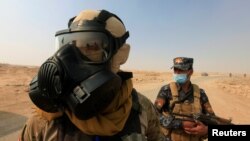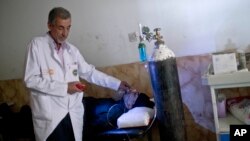The sulfur dioxide fire Islamic State militants triggered last week is only the first stage in a plan that will see the extremists resort to chemical warfare in a bid to stave off Iraqi and Kurdish forces from retaking Mosul, the terror group’s last major urban stronghold in Iraq, military experts fear.
Alarm is mounting that IS militants will use chlorine-filled improvised explosive devices in even greater numbers than in their defense last year of Tikrit, where they planted hundreds of chlorine IEDs and slowed the advance of Iraqi troops and Shi’ite militias. Some diplomatic observers argue the ferocity of the retaliation and abuses in Tikrit by Shi’ite militiamen after ousting the jihadists can partly be explained by fury over the chlorine IEDs.
“Mishraq is the first part of the IS plan to defend Mosul at all costs, with all weapons available,” says Hamish de Bretton-Gordon, an adviser to relief organizations working in Iraq and Syria, referring to the fire triggered at a chemical plant 30 kilometers from Mosul.
‘Almost limitless amount of chlorine’
Bretton-Gordon says the terror group’s chemical weapons program run by scientists who once worked for ousted dictator Saddam Hussein have “almost limitless amount of chlorine to fill into mortars, which they’ve used to attack the peshmerga for the last 12 months and IEDs.” The former British army officer suspects IS militants are manufacturing mustard gas in Mosul and worries coalition forces are ill-prepared for a CW attack.
Last year, French intelligence feared a possible mustard gas attack in Paris. After the Paris terror attacks that killed more than 140 people, the government authorized the distribution of atropine, an antidote to counter the potentially deadly effects of nerve gas.
The fear was that IS militants had managed to smuggle mustard gas into France. Bretton-Gordon told VOA at the time that IS wanted “to create as much terror as possible” by resorting to “the ultimate terror weapon.” In France, there was only a small chance of mustard gas being smuggled in, but with the battle for Mosul the militants have greater opportunities and stockpiles.
On October 22, as the multi-pronged offensive involving Iraqi security forces and Kurdish peshmerga fighters unfolded on the outskirts of Mosul, Iraq’s second largest city, IS fighters set fire to sulfur stockpiles at a chemical plant near Qayyara, southeast of Mosul. Noxious fumes drifted over an airfield that’s one of the main bases for the coalition assault on the Iraqi city.
The toxic, yellowish gas killed at least nine people, hundreds breathed in the fumes, and Iraqi and U.S. troops were forced to wear masks.
The toxic cloud included deadly sulfur dioxide and hydrogen sulfide and combined with residue from burning oil wells in a potentially fatal cocktail for those caught in the open or without gas masks, Bretton-Gordon wrote Sunday for a British news site.
“The toxic cloud stretched 20-30 kilometers to the south over sparsely populated grounds; if the wind changed to blow to the east, as it usually does at this time of year, there is a slim chance that the Kurdish capital of Irbil, 60 kilometers away could come under threat,” he added.
'Mass casualty management'
On Thursday, the U.N. health agency announced it has trained 90 Iraqi medics in “mass casualty management,” with a special focus on chemical attacks, as part of its preparations for the campaign to retake Mosul from IS. “It is no surprise that the ultimate terror organization is looking to the ultimate terror weapon, chemical, to save ‘Caliphate HQ,’” he argued.
He says the coalition forces, NGOs and aid workers need to be ready to combat chemical attack.
IS has resorted to CW attacks before. In September 2015, Kurdish commanders in eastern Syria accused IS militants of using poison gas, and Syrian rebels said the militants used artillery shells filled with mustard gas in two separate bombardments on the northern Syrian town of Marea, 10 kilometers from the Turkish border.
In eastern Syria, Kurdish leaders sent a specialized investigation team to the alleged gas attack site in the Salihiya area of Hasaka province. There were also reports that two days after the attack in Hasaka a rocket suspected of carrying chemical substances was fired by IS at Iraqi peshmerga positions near Mosul Dam. A month earlier during a battle near the northern Iraqi city of Makhmour, 60 peshmerga were exposed to mustard gas, Kurdish officials claimed.
U.S. and Western officials concluded the allegations about the use of mustard gas in 2015 were credible.
U.S. and NATO officials say it remains an open question as to where IS got mustard gas. The Syrian regime said it cooperated with the destruction of most of its chemical arsenal after the threat of U.S. airstrikes three years ago, following a sarin gas attack on a Damascus suburb. U.N. inspectors have expressed concern not all mustard gas stocks were burned away in sand pits as claimed.
Experts argue any Iraqi stockpiles from the Saddam Hussein era that may have escaped international weapons inspectors would be degraded by now. Some speculate mustard gas-filled shells may have been smuggled out of Libya. But the low concentrations of gas in the past IS attacks suggest to some experts the chemical weapon is being developed by IS.
Mustard gas causes blistering and weeping skin, a burning rash and breathing difficulties. It was first used in World War I and is banned under the 1925 Geneva protocol.










